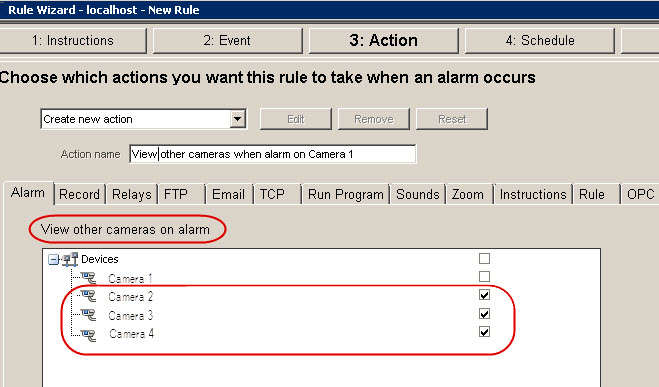An intruder breaks through door and enters room.
• Camera 1 focused on door.
• Cameras 2, 3, and 4 – all show interior space related to door.
• In Symphony Client 2 x 2 multi-view panels with no cameras currently displayed
Task:
• Set up Symphony so that image from Camera 1 appears immediately in a multi-view panel when an alarm is raised and that cameras near the door are also displayed immediately when an alarm is raised on Camera 1.
Set up rule in Rule Wizard
1. In the Rule Wizard, Camera 1, which is focused on a door, is selected. The appropriate Video Engine and mask are set up as necessary.
2. Click Next.
3. In the Alarm tab, you select all the cameras from which you want to see an image if an alarm occurs on Camera 1. In this example, you want to see images from Cameras 2, 3, and 4 if an alarm is triggered on Camera 1.

4. Click Next and set up the Schedule.
5. Click Save to save the Rule name for this scenario.
6. Click OK to close the Server Configuration dialog box.
Set up a camera view panel:
1. In a camera-view panel (for example, 2x2),
right-click ONLY on the first panel
(Panel 1).

2. From the context menu, select Settings. The Camera View Settings dialog box appears.
3. Click the Activity tab.
4. Select the Switch view when alarm occurs check box.
5. Select the Show alarm cameras in other panels check box. (This option forces all the other panels in the Multi-view to display images from cameras associated with Camera 1. Recall, in the Rule Wizard, Cameras 2, 3, and 4 were selected to be viewed if an alarm was triggered on Camera 1.)

When an alarm occurs on Camera 1, Panel 1 will now display the image from Camera 1 AND the other panels will display images from Cameras 2, 3, and 4.
